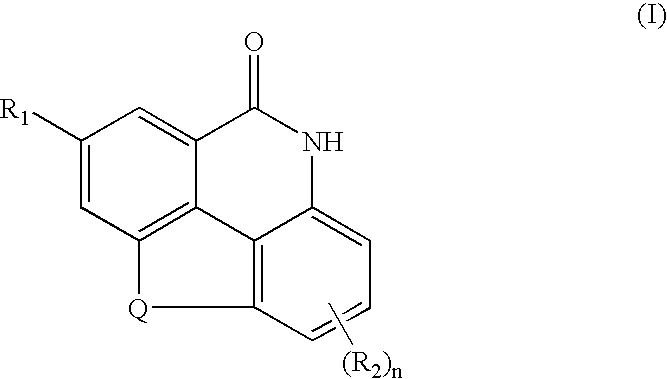Substituted 4,9-dihydrocyclopenta{imn}phenanthridine-5-ones derivatives thereof and their uses
a technology of phenanthridine and phenanthridine, which is applied in the field of substituted 4, 9dihydrocyclopenta imn phenanthridine5ones derivatives thereof, can solve the problems of rapid turnover rate, severe depletion of nad in cells suffering from massive depletion, and immediate activation of parp by up to 500-fold, so as to prevent, treat and/or ameliorate the effects of conditions
- Summary
- Abstract
- Description
- Claims
- Application Information
AI Technical Summary
Benefits of technology
Problems solved by technology
Method used
Image
Examples
example 1
1-(4-Pyridin-2-yl-piperazine-1-sulfonyl)-4H,9H-cyclopenta[lmn]phenanthridin-5-one
[0149]
[0150]Prepared from the reaction of sulfonyl chloride 5 (0.1 g) and 1-pyridin-2-yl-piperazine according to General Procedure A. The gray precipitation was collected by filtration, washed with water and acetone to give a solid (0.050 g, 38% yield). mp 263–270° C. 1H-NMR (300 MHz, DMSO-d6) □ 11.84(s, 1H); 8.04–7.97 (m, 3H); 7.78(d, 1H, J=3.33 Hz); 7.69(t, 1H, J=7.6 Hz); 7.48(t, 1H, J=7.6 Hz); 7.34(d, 1H, J=8.4 Hz); 6.70(d, 1H, J=8.6 Hz); 6.60(t, 1H, 6.0 Hz); 4.55(s, 2H); 3.60(s, 4H); 3.07(s, 4H);. Anal. (C23H20N4O3S). C H N S.
example 2
1-(5-Oxo-5,9-dihydro-4H-cyclopenta[lmn]phenanthridine-1-sulfonyl)-piperidine-3-carboxylic acid ethyl ester
[0151]
[0152]Prepared from the reaction of sulfonyl chloride 5 (0.12 g) and piperidine-3-carboxylic acid ethyl ester according to General Procedure A. The precipitation was collected by filtration, washed with water, ethyl acetate and acetone to give a solid (0.07 g). mp 215–218° C. 1H-NMR (400 MHz, DMSO-d6) □ 11.95(s, 1H); 8.01–7.98(m=2H); 7.76(d, 1H, J=8.4 Hz), 7.71(t, 1H, J=7.5 Hz); 7.35(d, 1H, J=8.4 Hz); 4.45(s, 2H); 4.06(m, 3H),; 3.57(m, 2H); 2.75(t, 2H); 1.72(s, 2H); 1.40–1.14(m, 5H,) Anal. (C22H22N2O5S 0.1 H2O). C H N S.
example 31
2-(4-Methyl-piperazin-1-yl)-N-(5-oxo-5,9-dihydro-4H-cyclopenta[lmn]phenanthridin-1-yl)-acetamide
[0153]
[0154]Prepared from the reaction of 2-chloro-N-(5oxo-5,9-dihydro-4H-cyclopenta[lmn]phenanthridin-1-yl)-acetamide 8 (0.65 g) and 1-methyl-piperazine (0.5 mL) according to General Procedure B. The precipitation was collected by filtration, washed with water, acetonitrile, to give a white solid (0.70 g, 91.8% yield). mp 180–185° C. 1H-NMR (300 MHz, DMSO-d6) □ 11.47(s, 1H); 9.96(s, 1H); 7.92(m, 2H); 7.63(t, 1H, J=7.8 Hz); 7.60(d, 1H, J=8.3 Hz); 7.15(d, 1H, J=8.2 Hz); 4.29(s, 2H); 3.21(s, 4H); 2.90(s, 4H); 2.75(s, 3H). Anal. (C21H22N4O2 1 HCl and 1.5 H2O) C H N.
PUM
| Property | Measurement | Unit |
|---|---|---|
| Temperature | aaaaa | aaaaa |
| Temperature | aaaaa | aaaaa |
| Temperature | aaaaa | aaaaa |
Abstract
Description
Claims
Application Information
 Login to View More
Login to View More - R&D
- Intellectual Property
- Life Sciences
- Materials
- Tech Scout
- Unparalleled Data Quality
- Higher Quality Content
- 60% Fewer Hallucinations
Browse by: Latest US Patents, China's latest patents, Technical Efficacy Thesaurus, Application Domain, Technology Topic, Popular Technical Reports.
© 2025 PatSnap. All rights reserved.Legal|Privacy policy|Modern Slavery Act Transparency Statement|Sitemap|About US| Contact US: help@patsnap.com



